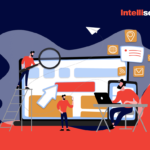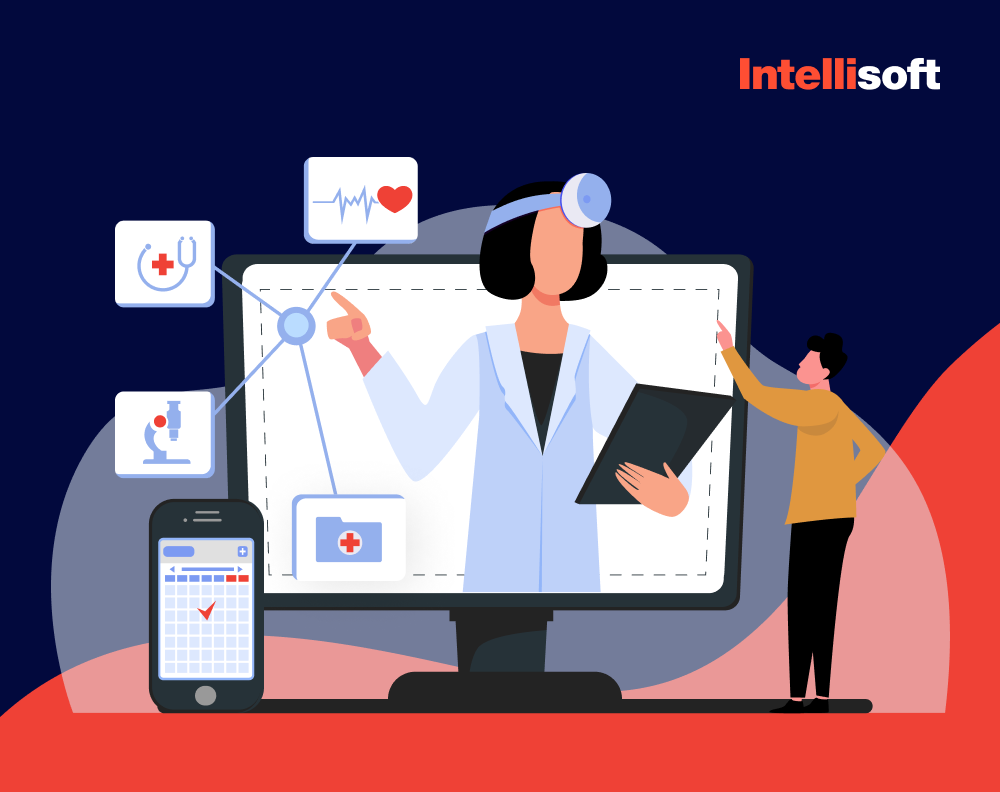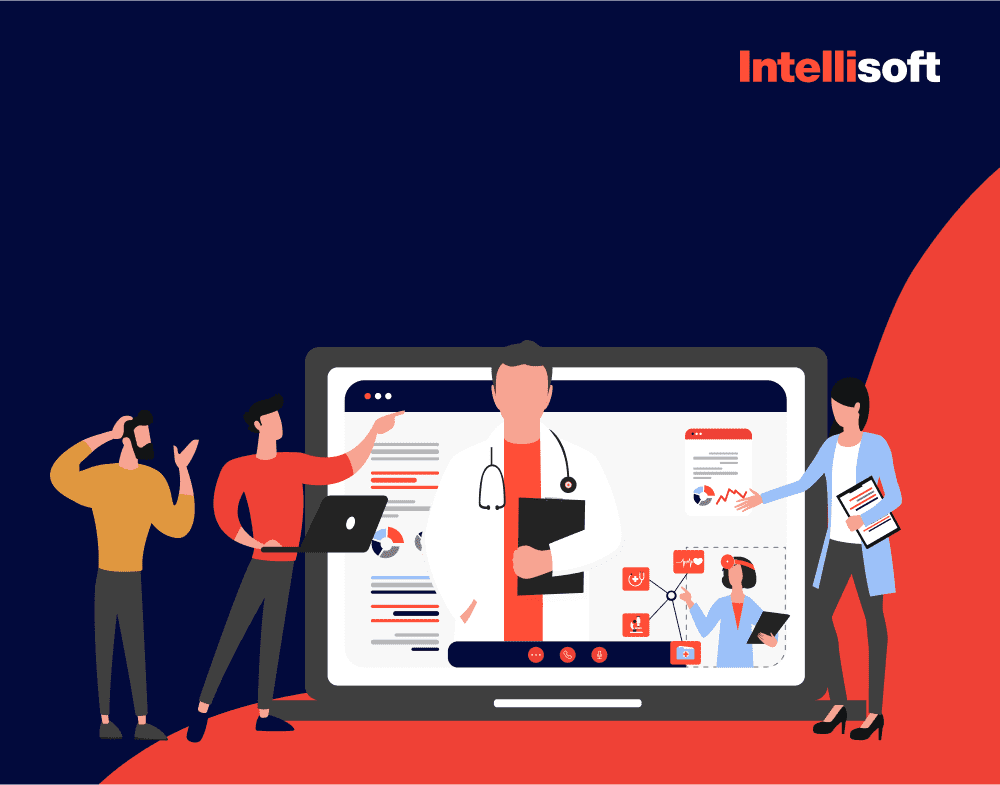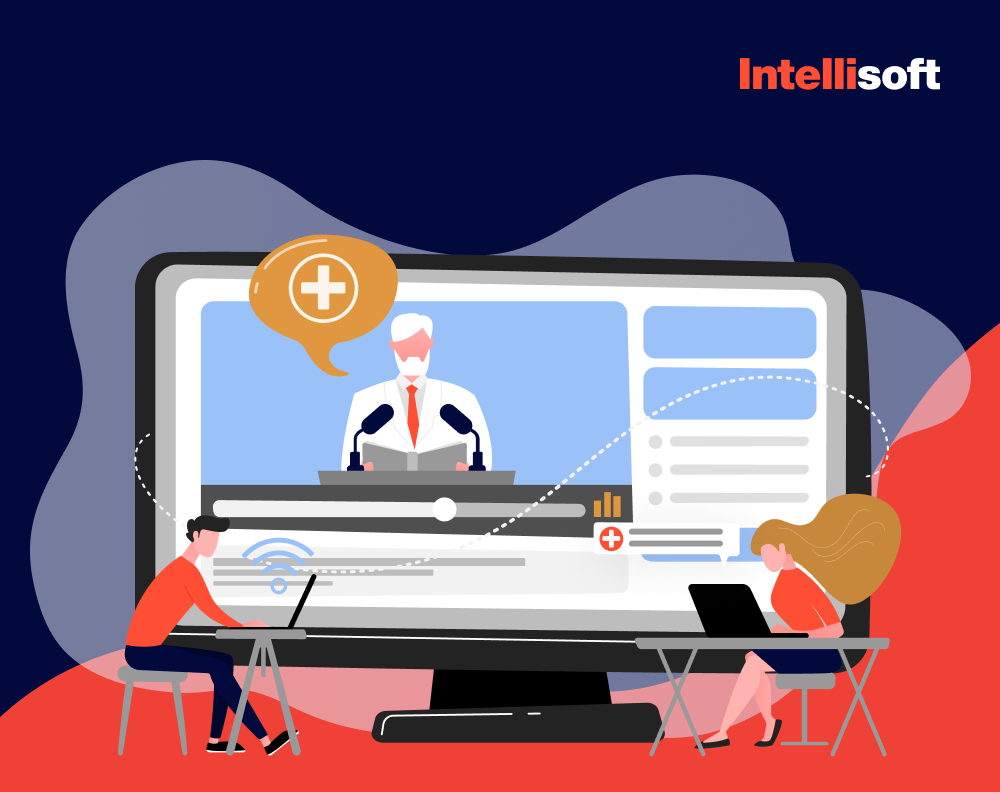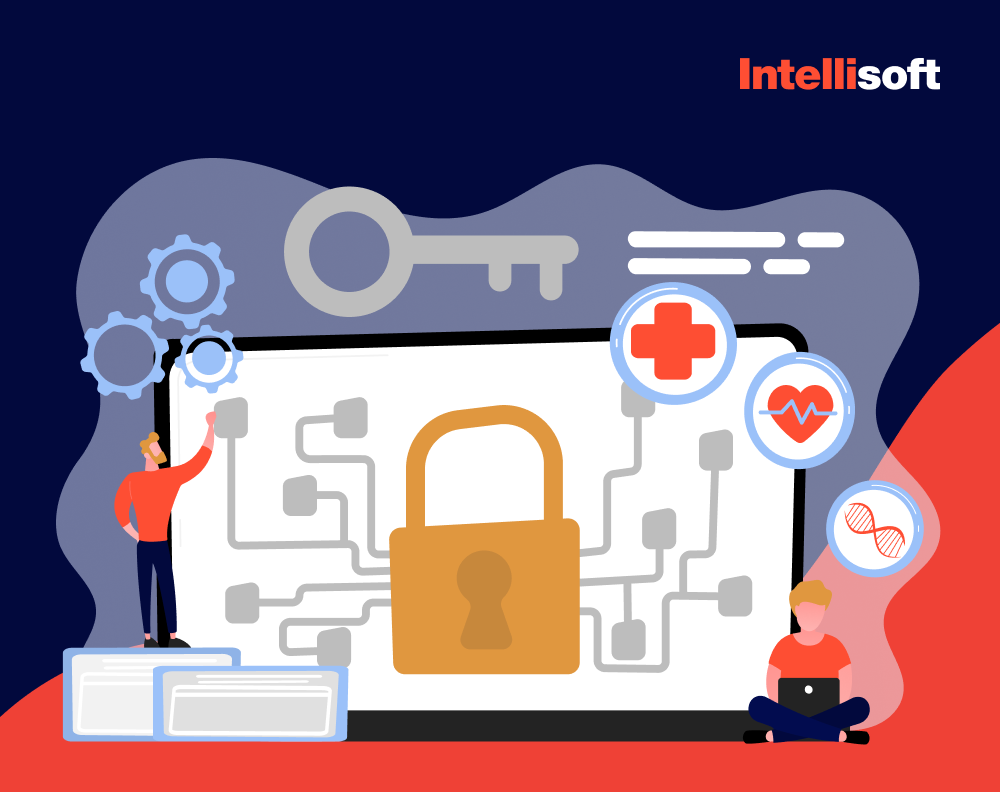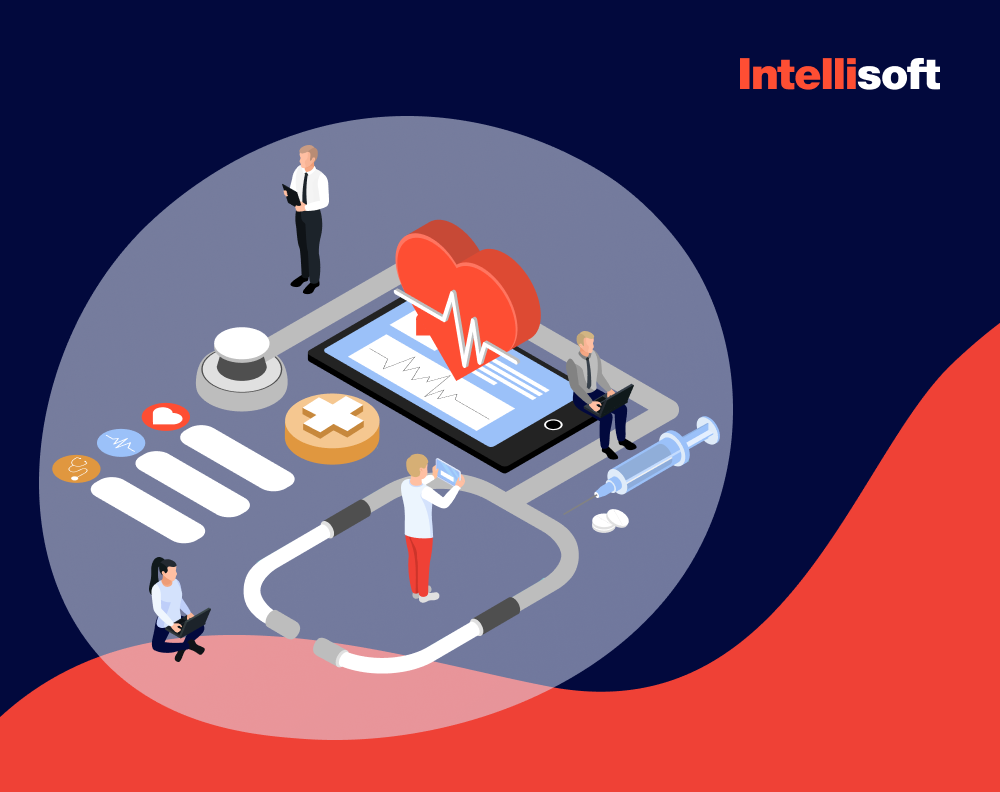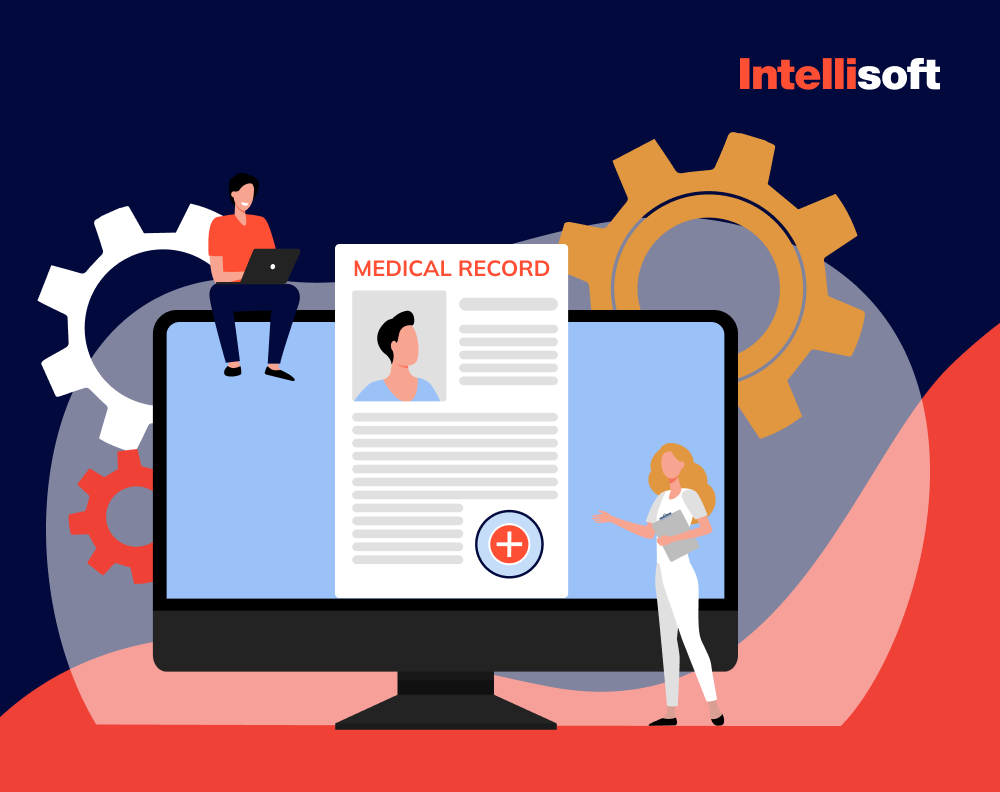Picture this; your team is scrambling to keep up with patient needs, endless paperwork, and a flood of communication that never seems to sync up. It’s frustrating, right? How do you ensure no detail slips through the cracks when you’re juggling so much? The pressure of delivering top-notch care while staying efficient can be overwhelming, and mistakes aren’t an option when patient well-being is on the line.
This is where care management software steps in – taking the chaos and turning it into clear, organized workflows. Imagine a system that keeps everyone on the same page, improves patient outcomes, and boosts your bottom line. But here’s the real question; how can you achieve this balance without adding more to your plate?
At IntelliSoft, we’ve spent 15 years perfecting that solution, blending technology with a deep understanding of the unique challenges in healthcare. We’re not just about streamlining processes – we’re about improving chronic care and disease management using software and helping you provide better care while driving growth and sustainability for your practice. In this article, we’ll explore how software fills in the gaps of care management.
Table of Contents
What is Care Management?

Care management is all about connecting the dots in healthcare, making sure no patient falls through the cracks. Think of it as a coordinated team effort where every aspect of a patient’s well-being is considered – whether it’s monitoring chronic conditions, planning treatments, or handling follow-ups. At its core, day care management software is designed to give patients a better quality of life while lightening the load on providers.
Here’s how it makes a difference:
- Boosts functional health. Whether physical or mental, child care management software helps patients stay engaged in everyday activities.
- Eliminates redundant services. By streamlining processes, it ensures that patients receive only the help they need, cutting down on repeated tests or procedures.
- Reduces hospital visits and complications. With a tighter grip on ongoing care, patients are less likely to face emergencies or require costly treatments.
- Encourages self-care. Care management motivates patients to take charge of their own health, improving outcomes and reducing long-term risks.
Most of these tasks happen behind the scenes, between appointments. Phone calls, telemedicine, and digital health tools are key, allowing caregivers to stay in touch without face-to-face meetings. And thanks to programs from the Centers for Medicare and Medicaid Services (CMS), professionals can be reimbursed for these efforts through initiatives like Chronic Care Management (CCM), Principal Care Management (PCM), and Transitional Care Management (TCM).
Here’s who’s on the CM team:
- Physicians across specialties
- Certified nurse midwives
- Clinical nurse specialists
- Nurse practitioners
- Physician assistants
However, anyone other than physicians must have proper authorization in their state to participate in health care risk management software programs.
Chronic Care Management

CCM focuses on patients with two or more chronic conditions that are expected to last for at least 12 months. The goal of chronic care management software is to keep patients healthier by providing ongoing support between face-to-face visits, reducing hospitalizations, and preventing the worsening of conditions. Child care management software teams collaborate to create comprehensive plans that address medication management, lifestyle changes, and regular check-ins via phone or telemedicine.
Key elements of chronic care management software include:
- Personalized plans. Tailored to the individual, outlining treatment goals and monitoring protocols.
- 24/7 access to care. Patients can contact their healthcare team whenever needed, increasing engagement and trust.
- Coordinated team efforts. Medical professionals from different specialties work together to ensure every aspect of the patient’s health is covered.
By focusing on consistent follow-up and patient education, CCM aims to improve the quality of life while reducing the strain on emergency services and hospital care.
Principal Care Management
PCM is designed for patients with a single chronic or high-risk condition that requires more intense management. Unlike CCM, PCM targets those whose care is centered around one condition, such as heart disease or diabetes, and focuses heavily on that condition’s management.
Key features of this patient care management software:
- Focused treatment plans. These plans hone in on a specific condition and its complications, with a more concentrated approach than CCM.
- Continuous monitoring. Patients benefit from close monitoring to prevent worsening conditions, hospital visits, or emergencies.
- Close collaboration with specialists. PCM often involves coordination with specialists who focus on the patient’s primary condition, ensuring detailed, condition-specific help.
PCM is ideal for patients who need intensive help for one significant health issue, allowing care management software healthcare providers to offer a higher level of support and more frequent intervention.
Transitional Care Management
TCM supports patients who are moving from a hospital or care facility back to their home. TCM aims to reduce hospital readmissions and ensure a smooth transition, as this period is often critical for preventing setbacks.
Key aspects of TCM include:
- Comprehensive follow-up. Patients receive post-discharge follow-up within two days, ensuring they’re adjusting to their medication, home care, and follow-up appointments.
- Medication management. Reviewing and reconciling medications is crucial to avoid complications that might arise from new prescriptions or changes.
- Patient and caregiver education. Providers ensure patients and their families understand how to manage recovery, recognize warning signs, and know when to seek further help.
TCM is particularly important for high-risk patients or those with complex medical needs, as it bridges the gap between hospital and home life, reducing the likelihood of complications.
CCM vs PCM vs TCM vs RPM: How They Work Together
CCM, PCM, TCM, RPM are all distinct but interconnected tools in the broader healthcare landscape. Each plays a specific role in patient care, and when combined, they create a comprehensive, continuous help system.
CCM vs PCM. While both focus on chronic conditions, CCM covers multiple conditions, providing a holistic view of the patient’s health, whereas PCM zeros in on managing one critical condition.
TCM’s role. TCM helps patients transition from hospital to home, acting as a bridge that ensures patients are stable and adhering to their treatment plans, whether they’re part of CCM or PCM.
RPM (Remote Patient Monitoring). RPM complements these services by collecting real-time data from patients’ homes, allowing healthcare providers to monitor conditions remotely. This continuous flow of data enriches both CCM and PCM, helping providers make timely adjustments to care plans.
Together, these programs offer a 360-degree approach to patient care, addressing every stage of a patient’s journey – from managing chronic conditions, and transitioning from hospital to monitoring health at home. When healthcare providers leverage them in combination, they create a robust safety net that ensures no patient is left behind.
Related Readings:
- The Internet of Things (IoT) in Health Care
- What is EHR Software?
- 9 Technological Trends in Healthcare in 2024
- IoT in Healthcare: Key Trends & Usages
- IoT Device Security Concepts
How Does Software Fill the Gaps of Care Management?
Health care management software is complex – juggling multiple patients, tracking health data, and ensuring no one slips through the cracks is a daunting task. This is where care management software steps in, acting like a central hub that ties everything together. From improving communication between healthcare teams to automating routine tasks, the right software transforms the way help is delivered.
“The integration of care management software into daily practice allows healthcare providers to coordinate better, monitor more effectively, and ultimately offer personalized help that meets the needs of each patient.”
— Robert Wachter, MD, Author of The Digital Doctor
With digital care management software, healthcare providers can:
- Streamline communication. Medical professionals can easily share updates, treatment plans, and progress notes, ensuring every team member stays informed and aligned.
- Enhance patient monitoring. Continuous monitoring tools and alerts help detect issues early, reducing the chances of complications or hospital readmissions.
- Personalize care plans. Software enables the customization of treatment plans based on real-time data, offering more tailored approach to each patient.
- Reduce administrative burden. By automating tasks such as appointment scheduling, medication reminders, and billing, software frees up valuable time for caregivers to focus on patient help.
Incorporating senior care management software doesn’t just improve efficiency – it bridges the gap between the patient and provider, making sure no crucial detail is overlooked. This technology allows healthcare professionals to stay proactive and agile, empowering them to deliver high-quality, individualized help.
Care Management Software: Key Features to Look For
Choosing the right health care management software is about more than ticking boxes – it’s about finding tools that genuinely make life easier for healthcare providers and patients alike. The software should integrate seamlessly into your practice, helping you work smarter, not harder, while improving patient outcomes. But with so many options out there, what features truly matter? Let’s break down the essentials with a few real-world examples of how they can transform care.
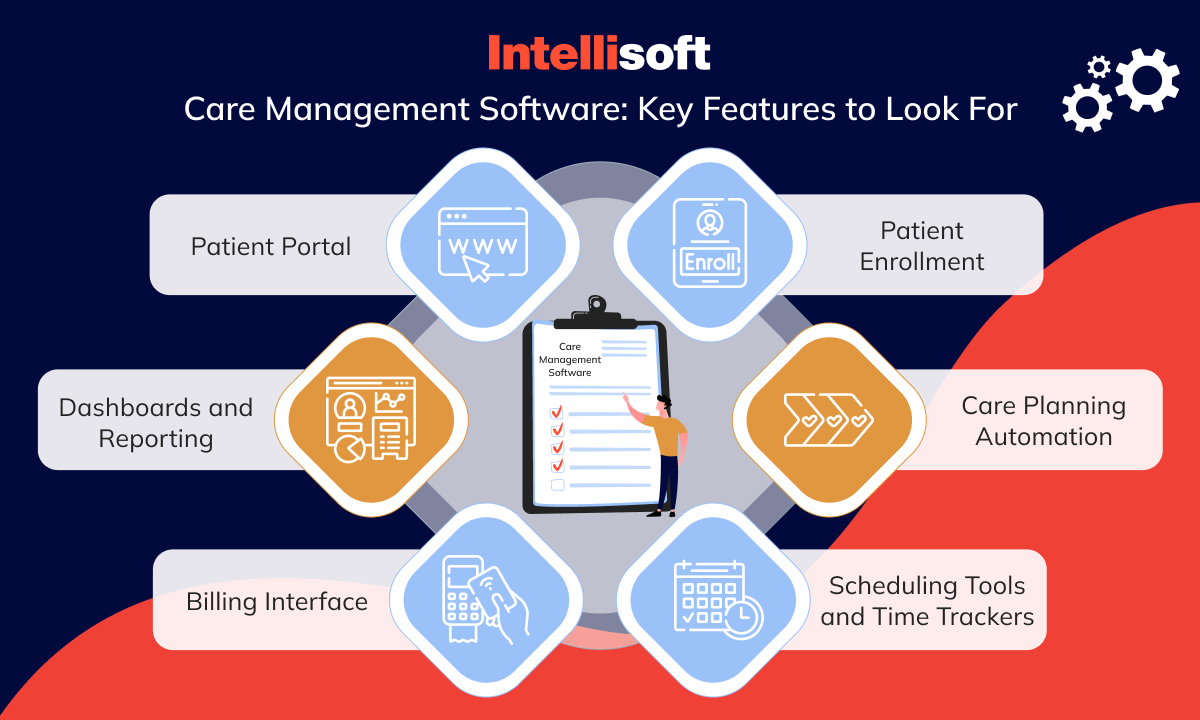
Patient Enrollment
Efficient patient enrollment is the first step toward smoother help management. The care management software for clinicians should make onboarding new patients a breeze, cutting out endless paperwork and data entry. Imagine logging in, entering a patient’s basic info, and having the system pull in their medical history, insurance details, and even flag any potential risks automatically.
For example, a nurse enrolling a patient with multiple chronic conditions shouldn’t have to manually input their entire medical history. With a robust enrollment system, they could simply scan insurance cards, import medical records, and have the system suggest care plans based on past conditions.
Care Planning Automation
Gone are the days of creating individual plans from scratch. With automated home health care management software, the software uses patient data to recommend personalized treatment plans. Whether it’s a diabetes patient who needs routine blood sugar monitoring or someone recovering from surgery, the software should build a plan tailored to each need.
Let’s say a physician is managing a patient with heart disease. Instead of spending valuable time crafting a plan manually, the software analyzes the patient’s vitals, medications, and past visits, automatically generating a comprehensive plan that includes check-ins, lifestyle advice, and medication schedules.
Scheduling Tools and Time Trackers
Managing appointments and making sure patients get the care they need on time can be chaotic, especially in busy practices. The right software should have smart scheduling tools that sync across devices, allow easy rescheduling, and even send reminders to both patients and staff. This ensures no one misses an appointment or follow-up, reducing no-shows and last-minute scrambles.
For example, a coordinator juggling a dozen appointments in one day can quickly pull up a patient’s profile, see the time they’re available, and book a follow-up without missing a beat. Time trackers can also help track the amount of time spent on help management activities, ensuring that healthcare providers can get reimbursed efficiently.
Billing Interface
Billing can be one of the most tedious parts of care management – navigating insurance codes, calculating co-pays, and making sure every service is accounted for. A strong billing interface streamlines this process by automatically generating bills based on services provided, and it should also integrate with insurance systems for smoother claims processing.
Imagine a patient receiving chronic care management through health care agency management software. Every phone call, follow-up, and treatment session can be tracked and billed without manual data entry. With the software automatically handling billing codes, caregivers can focus more on patient help and less on paperwork.
Dashboards and Reporting
Data is powerful, but only if you can access and understand it. Look for long term care management software that offers intuitive dashboards where caregivers can see patient progress, track outcomes, and identify any areas that need attention. Reporting tools should allow you to generate custom reports that help optimize help delivery.
For instance, a clinic administrator might want to see which patients are at high risk of hospitalization. The software could display this on a user-friendly dashboard, helping the team focus their efforts on those patients who need the most attention. The ability to pull these insights in real-time empowers healthcare teams to act faster and more effectively.
Patient Portal
A patient portal is a game-changer when it comes to engagement. This cloud based home care management software allows patients to access their medical records, care plans, and upcoming appointments from the comfort of their own homes. They can also use in home care management software to communicate with their care team, ask questions, or even update their health status in real-time, fostering better communication and involvement in their own care.
For example, a patient managing chronic conditions could log in to their portal, view their prescribed medications, track their blood pressure, and message their doctor with concerns – all without stepping foot in the office. This not only saves time but also keeps patients more involved in their health journey, which leads to better outcomes.
Other Things to Consider Apart From Features
While features are undeniably important when choosing care management software, there are several other critical factors that can make or break its effectiveness in your practice. Beyond the bells and whistles, you need to ensure that the software you choose is secure, compatible with your existing systems, easy to use, and supported by a reliable team. Here are the key considerations:

Compliance and Security
In healthcare, patient privacy is paramount, and so is compliance with regulations such as HIPAA (Health Insurance Portability and Accountability Act). The care management software solutions you choose should have top-tier security measures, such as data encryption, secure logins, and audit trails to ensure patient data is protected at all times.
For example, imagine you’re managing sensitive patient health records in a diabetes care management software. The last thing you want is a data breach that compromises that information. Strong security features help you avoid these risks, ensuring peace of mind for both your team and your patients.
Compatibility with Your EHR
One of the biggest challenges when finding chronic care management software companies and integrating new software into a healthcare practice is ensuring it plays well with your existing systems – especially your Electronic Health Record (EHR). The care management software you choose should seamlessly integrate with your EHR so that patient information flows easily between systems, avoiding double entry and minimizing errors.
Think of it this way; if your care management software and EHR are incompatible, your team could end up wasting hours manually transferring patient data between systems, leading to inefficiencies and possible mistakes. A smooth integration means less administrative work and more focus on patient care.
Ease of Use
No matter how powerful the health care case management software is, if it’s too complicated for your team to use, it’s not going to deliver results. A user-friendly interface is essential. Your staff should be able to navigate the system without feeling overwhelmed or frustrated. Ideally, the software should be intuitive, with minimal learning curves, so your team can hit the ground running.
Imagine a nurse logging in to schedule a follow-up. If they have to click through multiple confusing menus or dig through dense settings just to book an appointment, the software is doing more harm than good. User-friendly design ensures that everyone – from physicians to admin staff – can focus on their tasks without software-related bottlenecks.
Customer Support
Even the best software can run into issues, and when it does, having responsive, helpful customer support is crucial. You don’t want to be stuck in a critical moment without guidance. Choose health care management software companies that offer 24/7 customer service, whether it’s via phone, chat, or email. Quick response times and knowledgeable support staff can make all the difference.
Consider this; a doctor encounters an issue with the billing interface right before a major deadline. With excellent customer support, they can resolve the problem within minutes. Without it, they might face significant delays and frustration.
Availability of Educational Content
Training your team on new software takes time, and having access to high-quality educational resources – such as tutorials, webinars, and FAQs – can make this process much easier. These resources help ensure your team is fully equipped to take advantage of all the features the software has to offer.
For instance, when onboarding a new staff member, having access to video tutorials or user guides can dramatically shorten the learning curve. It ensures that your team gets the most out of the software, even as it evolves with new updates or features.
Pricing
Finally, chronic care management software pricing is always a crucial factor. Care management software can range from affordable to premium, and while it’s tempting to go for the cheapest option, make sure the software provides value in terms of its features, security, and support. Look at the long-term return on investment: how much time and effort will this software save? How will it impact patient outcomes?
A common scenario might involve balancing the cost of the software with the revenue it helps generate – whether through improved efficiency, reduced hospital readmissions, or more accurate billing. Weigh the price against the benefits to find a solution that fits your budget and your practice’s needs.
9 Care Management Solutions For 2024
Choosing the right care management software and care management software vendors is crucial for improving patient outcomes and operational efficiency. Here are 10 leading care management software systems for 2024, each offering unique features to help healthcare providers deliver more coordinated, personalized care.
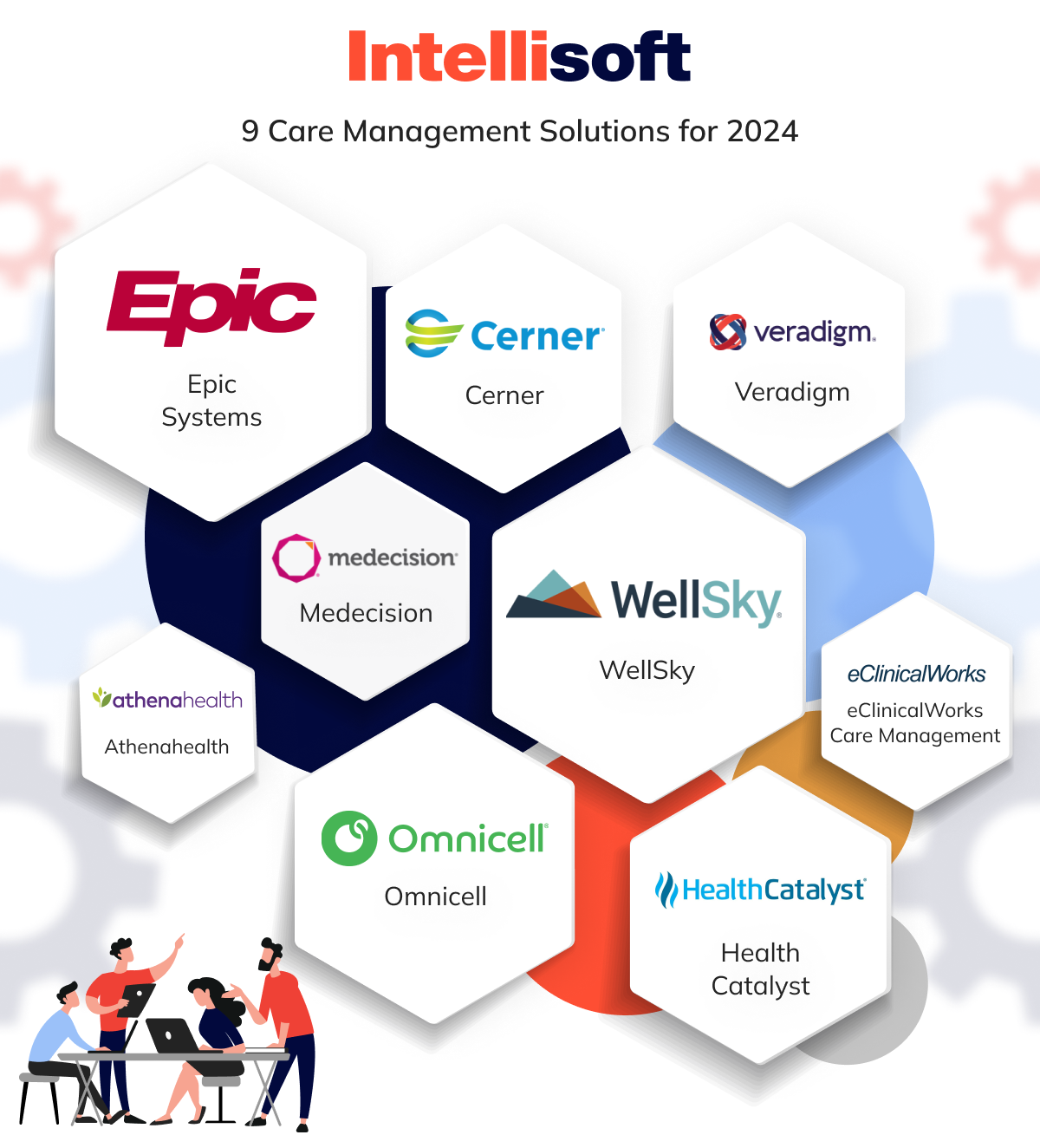
Epic Systems
Known for its extensive EHR integration, Epic Systems offers robust care management tools for patient engagement, telemedicine, and health monitoring.
Cerner
Cerner delivers comprehensive care coordination and data analytics to streamline patient management and reduce hospital readmissions.
Veradigm
Veradigm focuses on reducing costs and improving outcomes through efficient patient tracking and automated workflows.
Medecision
Medecision’s platform excels in population health management, offering predictive analytics to enhance care delivery and reduce complications.
eClinicalWorks Care Management
This solution provides real-time data sharing and integrates with telemedicine, making it ideal for chronic care management.
Health Catalyst
Health Catalyst emphasizes data analytics and machine learning to help providers deliver personalized care plans based on patient needs.
Athenahealth
A cloud-based platform with tools for care coordination, Athenahealth offers streamlined scheduling, billing, and reporting for healthcare teams.
WellSky
WellSky focuses on long-term and post-acute care, providing solutions for care coordination, patient engagement, and compliance tracking.
Pharmacies-Based Solutions (e.g., Omnicell)
Omnicell and similar solutions offer medication management tools that integrate with care management systems to ensure proper prescription handling and patient safety.
Comparison Table
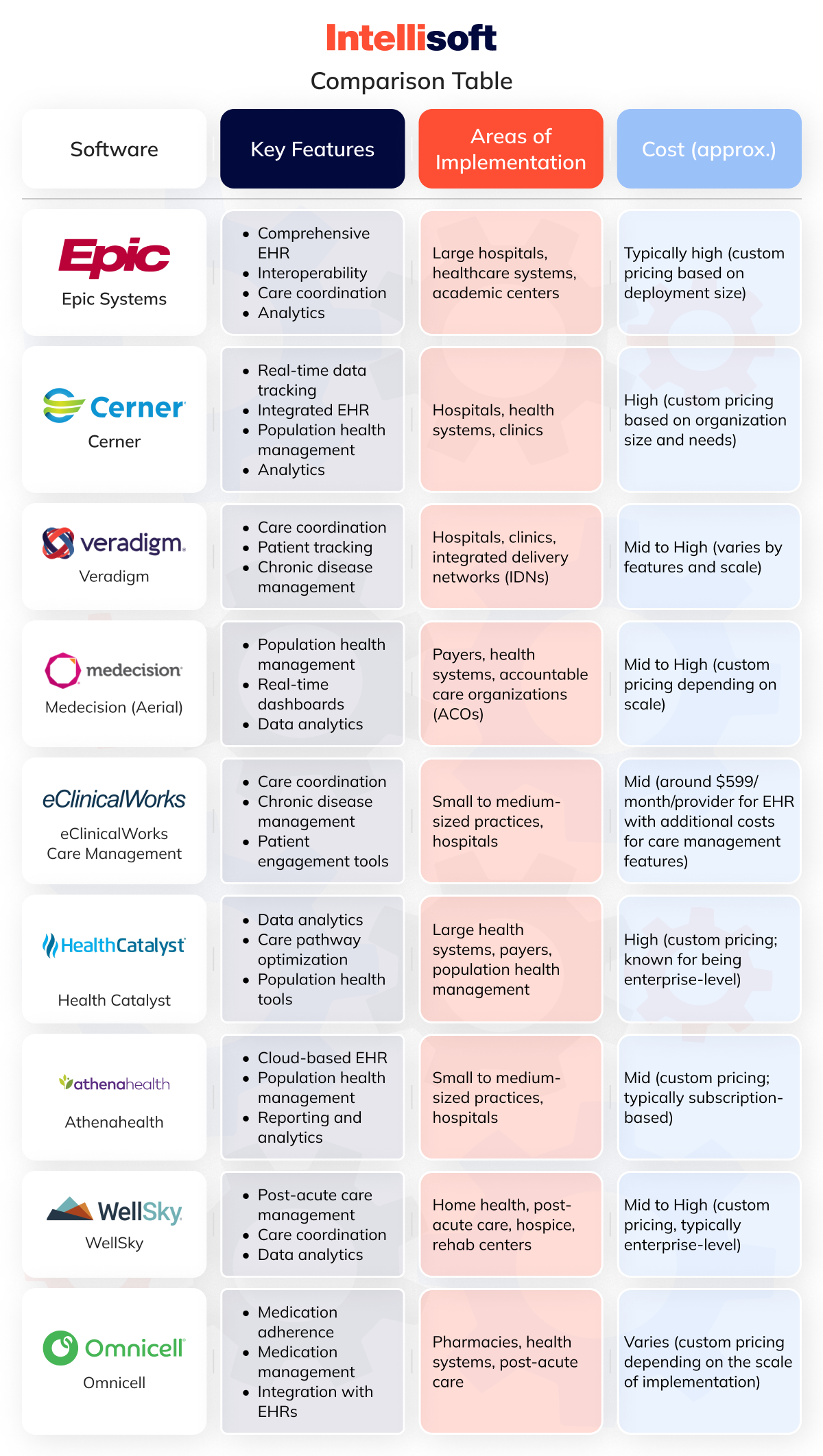
When to Develop Custom Care Management Software?
Off-the-shelf care home management software can be highly effective, but it doesn’t always meet the specific demands of every healthcare organization. When faced with unique needs or limitations in standard solutions, developing custom care home management software systems becomes a strategic choice. Here are key scenarios when building a tailor-made solution could be the best approach:
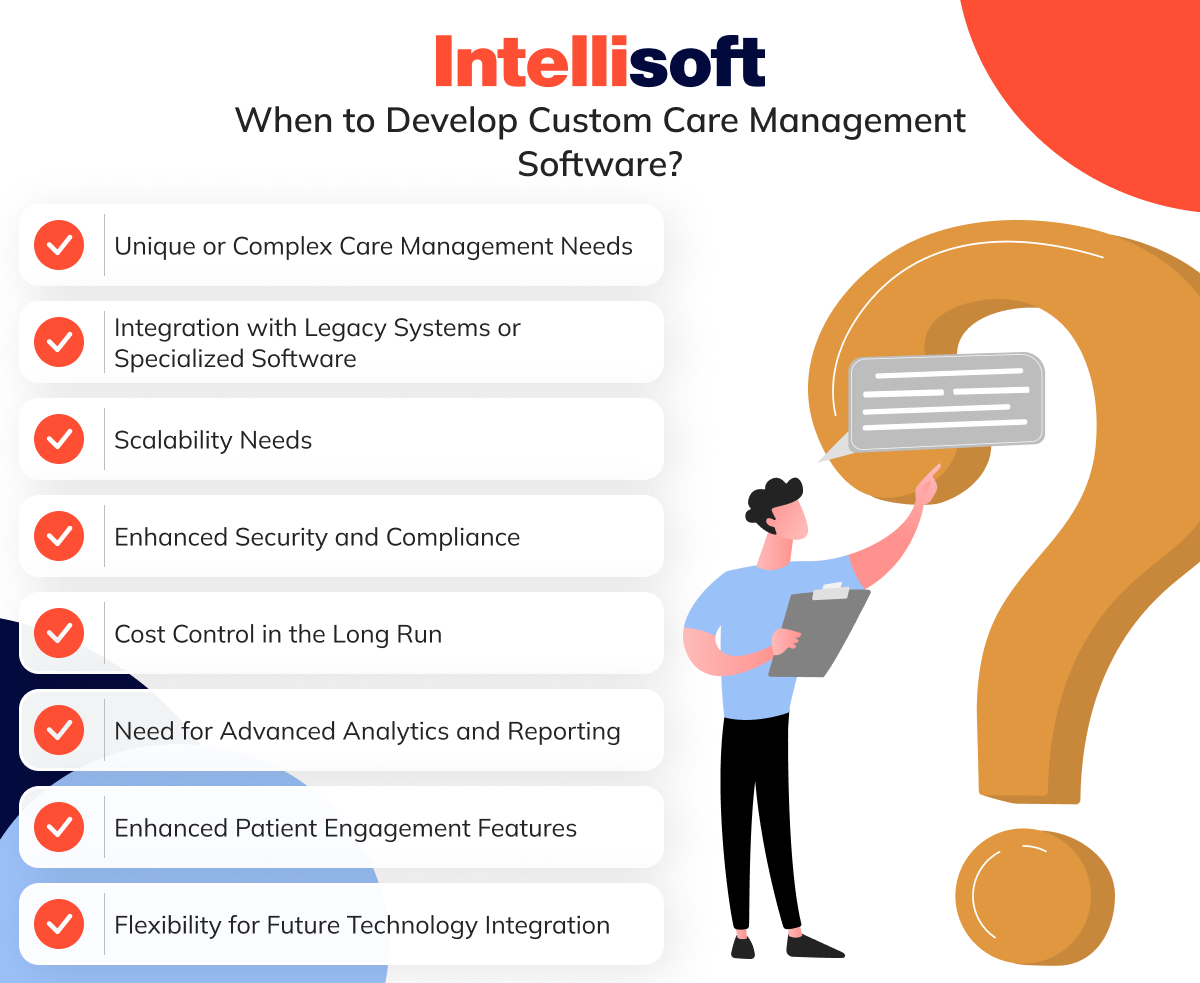
Unique or Complex Care Management Needs
If your healthcare facility manages intricate workflows, specialized treatment protocols, or complex data management requirements, off-the-shelf solutions may fall short. Custom aged care management software allows you to design a system that fits your exact clinical processes, enabling smoother operations and more precise care coordination. For instance, specialized clinics handling rare diseases or long-term chronic care may require features that general software doesn’t offer.
Integration with Legacy Systems or Specialized Software
One of the major challenges with ready-made software for chronic care management is compatibility with your existing systems. If you’re working with legacy Electronic Health Records (EHR) or specialized billing and scheduling software, a custom solution can be designed to integrate seamlessly. This ensures that all systems communicate efficiently, eliminating data silos and reducing the risk of errors that come from manual data transfer between platforms.
Scalability Needs
As your healthcare practice grows, so do your needs for larger patient databases, more complex workflows, and additional staff. Standard software might not scale effectively to handle such growth, leading to performance bottlenecks. Custom care management software for behavioral health allows for scalability, ensuring the system evolves alongside your organization without sacrificing performance or patient help quality.
Enhanced Security and Compliance
With patient data security at the forefront of healthcare concerns, meeting strict compliance requirements such as HIPAA with Medicare chronic care management software is non-negotiable. While many off-the-shelf solutions offer basic compliance features, custom software can be built with advanced security measures tailored to your specific regulatory environment. This ensures that patient data is protected through end-to-end encryption, multi-factor authentication, and tailored access control, reducing the risk of breaches or fines.
Cost Control in the Long Run
While developing custom elder care management software requires higher upfront investment, it can actually reduce long-term costs. Off-the-shelf solutions often come with recurring licensing fees, upgrades, and sometimes features you don’t need. Custom software allows you to pay once for exactly what you require, with the flexibility to adjust features over time without ongoing payments for unused capabilities. As a result, it can offer better return on investment for healthcare organizations with long-term growth plans.
Need for Advanced Analytics and Reporting
If your healthcare facility relies heavily on data-driven decision-making, custom perfect care practice management software gives you the flexibility to implement advanced analytics tailored to your specific needs. You can build in features that track and report on key performance indicators (KPIs), patient outcomes, and treatment effectiveness, helping improve help quality and operational efficiency. Whether you need real-time monitoring of patient vitals or insights into chronic disease management, custom analytics can give you a competitive edge.
Enhanced Patient Engagement Features
Patient engagement is a critical part of modern healthcare. With custom care management software for addiction, you can design tools that cater directly to patient needs, such as personalized health portals, appointment reminders, or remote health tracking. These features can help improve patient satisfaction, reduce missed appointments, and promote active participation in their own care, leading to better outcomes and higher retention rates.
Flexibility for Future Technology Integration
Healthcare technology is rapidly evolving, from AI-driven diagnostics to telemedicine platforms. Custom care quality management software gives you the flexibility to integrate future technologies as they become relevant to your practice. Whether it’s integrating AI for predictive analytics or telemedicine features to expand remote help, a custom solution allows you to stay ahead of the curve and continuously innovate without needing to switch systems.
When Not to Consider Custom Solutions
While custom help management software offers many benefits, it’s not always the right fit. Here are some scenarios where opting for a pre-built solution may be more practical:
Limited Budget
Custom development comes with high upfront costs. For smaller practices or those with tight budgets, off-the-shelf solutions are often more affordable.
Time Constraints
Custom software can take months to develop. If you need a solution quickly, pre-built options provide faster implementation.
Standard Workflows
If your practice follows typical care management processes, off-the-shelf software is likely sufficient without the need for customization.
Lack of IT Resources
Custom home health care agency management software solutions require ongoing maintenance. If you lack an in-house IT team or prefer not to outsource, stick with commercially available products that come with built-in support.
Low Scalability Needs
If your organization isn’t rapidly expanding, a pre-built solution with flexible scaling options may be more cost-effective than custom software.
No Specialized Integration Needs
If your systems are compatible with standard EHRs, off-the-shelf solutions likely offer all the integrations you need.
Sufficient Features
If existing software already meets your core needs, there’s no need to invest in custom development for additional features you may not fully use.
Uncertain Strategy
If your organization’s goals are in flux, it’s safer to choose a pre-built solution that allows flexibility, rather than committing to a costly, long-term custom project.
Conclusion
Delivering top-notch patient care is never easy, especially when you’re juggling multiple tasks, compliance concerns, and ever-evolving patient needs. Care plan management software can be a game-changer, streamlining everything from patient enrollment to complex care planning.
But finding the right solution isn’t just about ticking off a list of features. It’s about choosing a tool that fits your practice’s unique workflows, enhances patient engagement, and ensures your team can focus more on help and less on administrative headaches.
If you’re unsure whether an out-of-the-box solution will cut it or if custom software is the way to go, IntelliSoft is here to help. With 15 years of experience in healthcare technology, we can work with you to create or implement a solution that meets your exact needs. Reach out today, and let’s start simplifying help management together.

